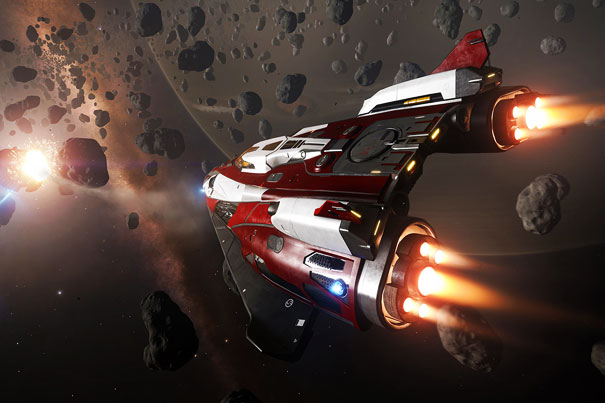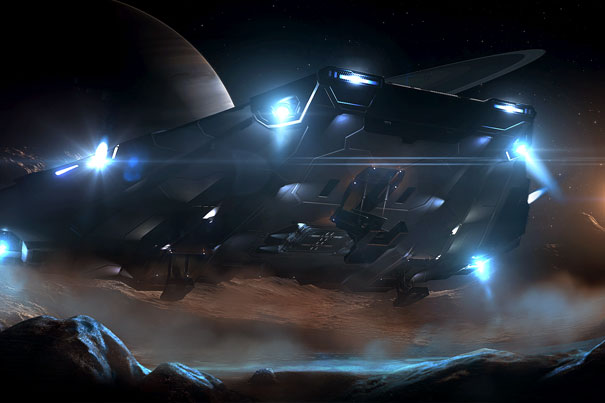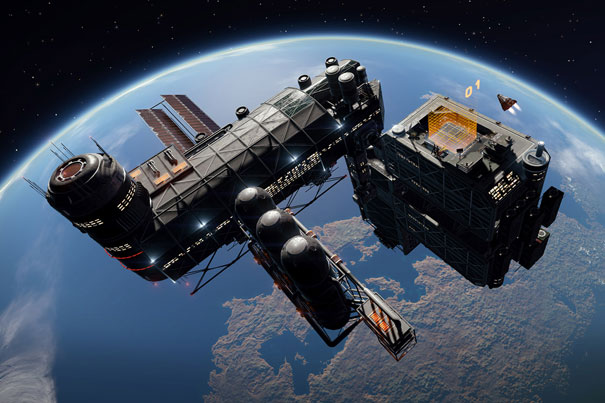
Star Wars: The Force Awakens reached the public at about the same time a science-fiction computer game, Elite Dangerous, “landed” its new expansion, Horizons, giving users the option to land on planets. Time to ask if there is much difference between the fiction in movies and games?
A stream of new cinematic in-game sequences from Elite Dangerous: Horizons revealed the excitement of the community that, for quite some time now, has been crossing the galaxy, both known and unknown, within the confines of a game which started some 30 years ago as a dream served with simple graphics. Powered by modern machines, Elite Dangerous (now Elite Dangerous: Horizons, with the new expansion), offers a unique immersive experience in the Universe existing around the planet Earth.
From multiple screens used together to create immersive walls to virtual reality devices like the Oculus Rift, gamers have had a fantastic experience flying their space ships freely within the 400 billion stars present in the game. And once they had the chance to have a virtual camera outside their spaceships, they started to create new immersive videos of that experience.
Since the early days of machinima that we’ve seen what can be done using game engines to create movie-like experiences. It is nothing new, but it’s getting so powerful these days, that it is difficult, sometimes, to know if a video sequence is the result of a CGI segment created for a movie or the result of “filming” action inside a game.
The videos used to illustrate this are present on this page, and go from the Horizons Cinematic proof of Concept (see above) from BlackMaze, presented as “just a very quick experiment recording something cinematic on the surface of a desert planet” to the launch video for Elite Horizons published by the developer, Frontier Development (see below). But the discovery of the filming possibilities of Elite, something inherent to the universe of many games, does not stop there.
In fact, while preparing the launch of the Horizons expansion, Frontier launched their Elite Dangerous Pioneer Programme, inviting videomakers to create work using the game engine, and to share it with the world. They were doing nothing new, simply creating a framework for something that has been happening for months now: the creation of video content using the game as a stage.
The capture of video in games is nothing new, and modernly we’ve even assisted to the launch of livestreams of games, some of which people subscribe to, allowing the creators of the livestream to monetize their sharing experience. Livestream of games is rapidly becoming a business, and that explains why even YouTube created a YouTube Gaming channel for people to stream their adventures in video games. The rise of eSports has contributed to the growth of this market segment, and the number of viewers is growing to millions, rapidly, suggesting many people will rather watch someone else playing than play the game themselves. And yes, some people do watch more game livestreams than TV.
Anyway, back to the point of this article, while many videos of games are simply created to show the action or the victory over enemies, quite a lot of them are created to tell stories, much like the early examples of machinima, which can be traced back as far as the 1980s, although the term first appeared in January 2000, when Hugh Hancock, the founder of Strange Company, launched a new website, machinima.com. The name, a misspelled contraction of machine cinema (machinema), relates to the use of real-time computer graphic engines to create cinematic productions.
Machinima continues very much alive today, although it may not be news, and the tools have become more sophisticated, as the SFM, or Source Filmmaker, reveals. The SFM program is a free software which allows video capture and editing, that works from inside the Source game engine. The tool, developed by Valve Corporation since 2005, was used to create multiple animated shorts, and is available to the gaming community using the Steam service.
In this context, it makes complete sense to ask what would George Lucas do if he had these tools available when the first Star Wars movie was created, especially knowing what the filmmaker did with some of the saga films when he had access to computers. As for J. J. Abrams, it is easy to believe he is well aware of the options computer games offer, as he was involved with the production of a video game in 2009 – Star Trek D.A.C. – and is referred as the producer behind Portal and Half-Life, two future movies based on the games universe created by Valve Corporation (Steam).

When Frontier Developments launched their callout to videomakers, streamers and content creators, telling them they would “love to work with you to help get Elite Dangerous out to the eyes and ears of the world!”, the immediate replies suggested the excitement the proposal raised. Comments like “Elite: The Movie…. Coming Summer 2017” to “this would be SO awesome. I’ve been hankering for a good space opera series since Battlestar Galactica”, through suggestions like “how about a movie, then a series? Sort of like the mini-series that started Battlestar”, while others asked for one thing that is essential for better movie making: more freedom for the in-game cameras filled the conversations at Frontier’s web pages dedicated to Elite Dangerous.
In fact, although the virtual cameras in games allow for angles of capture that are many times impossible to recreate in real life movie making, the available camera in Elite Horizons is still limited, and wannabe filmmakers using the game engine hope that Frontier creates the means to make it more versatile. Some users are talking about making the virtual camera work as if mounted on a crane, while others suggest removing the cockpit for filming purposes would allow the use of a 6 axis dolly system offering unique perspectives. In 2014 I created a video using the Elite game engine which could well do with such arrangement. At the time there was no external camera available, so all the video sequences were shot from the cockpit.
Whatever Frontier Development does to further improve the movement of the virtual camera in the game, it will expand the possibilities when it comes to creating not only sequences of action, but also full stories around this sci-fi universe. Simply searching for “Elite Dangerous or Horizons cinematics” in YouTube gives a growing number of examples, some already venturing into the voice acting and storytelling areas.
I use another example from YouTube user BlackMaze to show there is a new breed of filmmakers (or machinimists or machinimators)wanting to use the game engines for telling stories (see above). But there are other examples available online, from multiple games allowing the use of their respective engine, showing this is a viable way to tell stories.
One question comes to mind at this point: is the fiction created inside a game like Elite Dangerous: Horizons so much different from the fiction created for a film like Star Wars or Star Trek? Is it “more real or better in the movie than on the game”? If we consider that much of what we see in movies these days is CGI, made in a computer, does it really matter? Probably not. It’s the story, the way it unfolds and the ability of the filmmaker and actors to build that sense of immersion that really counts. And we’re already seeing some examples of the efforts those “videogame filmmakers” are making. Maybe some of the future “J.J. Abrams and George Lucas” of the industry start their career in the universe of games. In the end, it’s all about entertainment.

Filmtools
Filmmakers go-to destination for pre-production, production & post production equipment!
Shop Now













